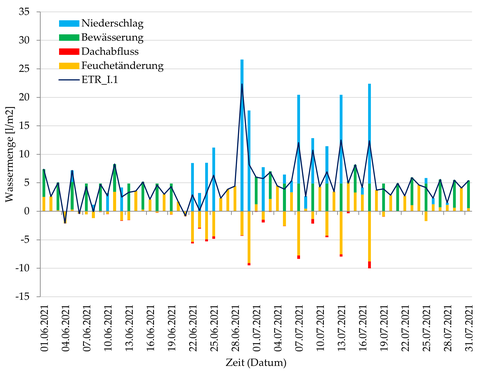Diploma thesis Philipp Hänicke
Building physical measurement data analysis for green roof test fields on the site of the Botanical Garden in Dresden
Bauphysikalische Messdatenanalyse für Gründach-Testfelder auf dem Gelände des Botanischen Gartens in Dresden

Evapotranspirationsbilanz im Feld 1
Green roofs are a very efficient way to counteract the effects of increasing urban sealing. The positive effect of green roofs extends from the improved microclimate, i.e. more balanced temperature conditions on the roof cladding and in the roof environment, higher moisture level), improved sound insulation, improved longevity of the underlying roof structure,
improved insulation, improved retention of precipitation water, and air pollutant
to air pollutant retention. The palette of green roof constructions is very
The range of green roof designs is very broad, from intensive green roofs, which have a greater variety of vegetation and height and are fully accessible and usable, to extensive green roofs, which have more robust plantings with lower growth height and less maintenance (no irrigation or horticultural care), there are numerous variations. An intermediate solution between intensive and extensive greening is simple intensive greening. This is based on robust planting that is only watered during dry periods.
Such a simple intensive greening was implemented in several test fields on the grounds of the Botanical Garden in Dresden as part of a joint research project. In these test areas, numerous sensors are used to record how the water balance and thermal behaviour of the green roof behave over the course of the year depending on the operating conditions. The test areas are thus subjected to different intensities, degrees of sunlight and dimensions measured on the test areas. A special feature is irrigation with grey water, which is drained from the sanitary rooms (washbasins and showers) of the adjacent building and collected, treated and stored in a 3.5 m³ storage tank for irrigation.
From this reservoir, irrigation of the roof areas (each approx. 3.5 m² in size) is carried out at staggered intervals with 17 litres of water at intervals of 2 days, 4 days or 8 days. The impact of these irrigation methods on the planting and the water balance of the test areas is one of the research topics. The latter is also the subject of the diploma thesis. In a first step, an inventory of the test areas and all sensors relevant to the building climate (location, measured quantity, measurement accuracy, calibration requirements) is to be made and illustrated. For these sensors, it has to be recorded, which periods of measurement data are available and which of them seem to be suitable for an evaluation. For this purpose, measurement data characteristics (statistical characteristics: min, max, sums, frequency distribution characteristics, etc.) must be recorded and measurement data failures quantified. This inventory results in vegetation periods, which are suitable for evaluation. These are to be examined in detail, in which some of the core questions of the research project are addressed. in the research project are addressed. These include the evaluation of surface temperatures and substrate moisture contents, the course of the year (dependence on irradiation, precipitation, etc.) and the determination of the evaporation capacity of the green roof areas in comparison with different irrigation distances and, if applicable, different sunlight phases. The findings from these data evaluations are to be summarized and translated into recommendations for the operation of such simple intensive green roofs
Supervisor
The work was mainly supervised by Dr.-Ing. P. Freudenberg, supported by Dipl.-Ing. Heiko Fechner.
 © Dr. Ing. Peggy Freudenberg
© Dr. Ing. Peggy Freudenberg
Chair Representative
NameDr.-Ing. Peggy Freudenberg
Send encrypted email via the SecureMail portal (for TUD external users only).
